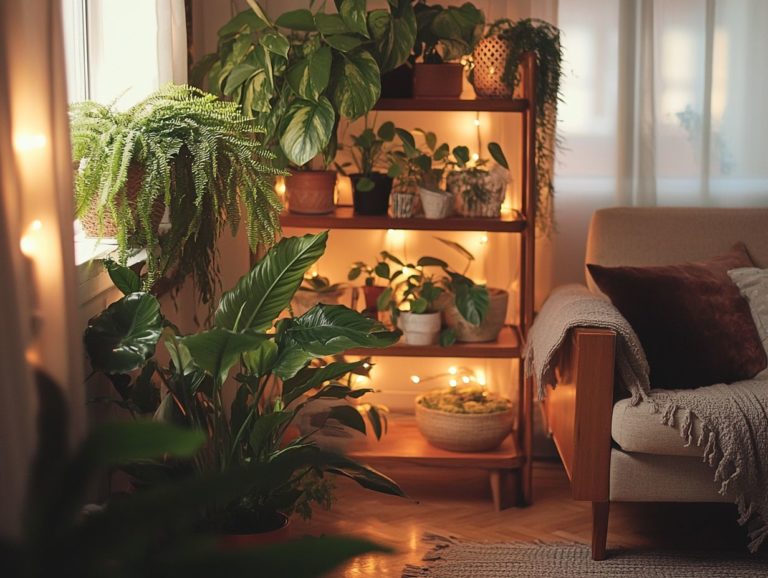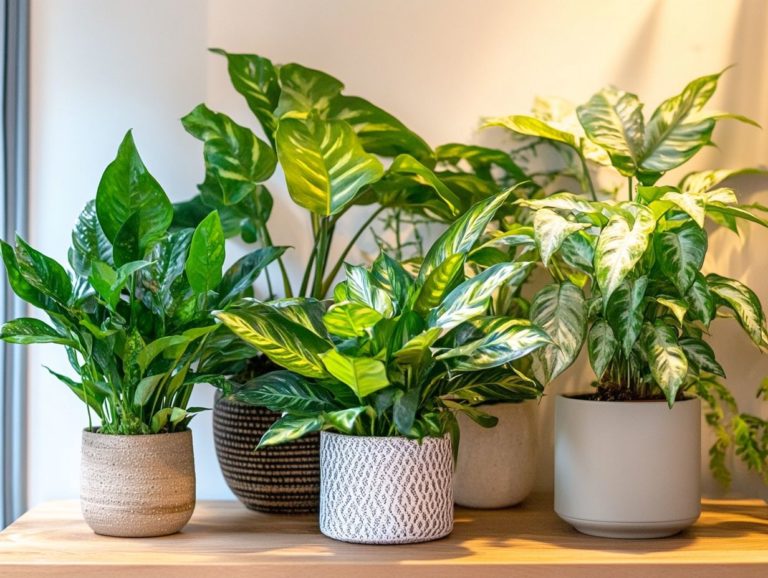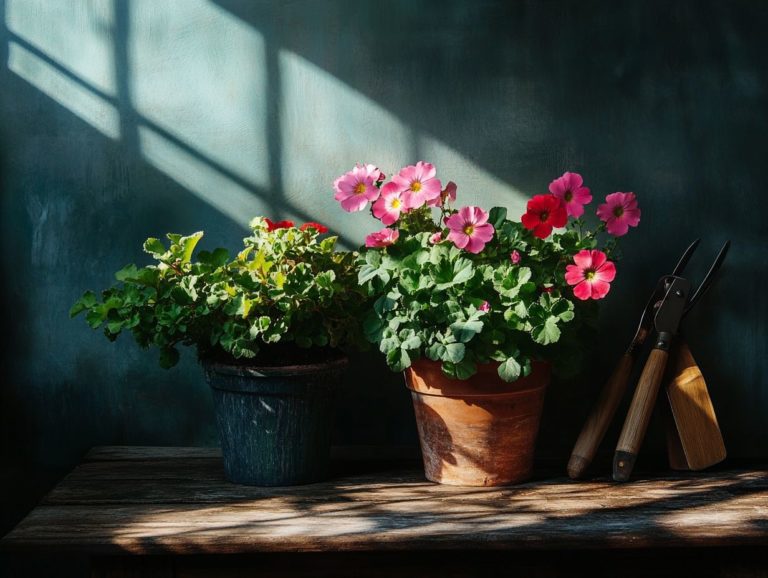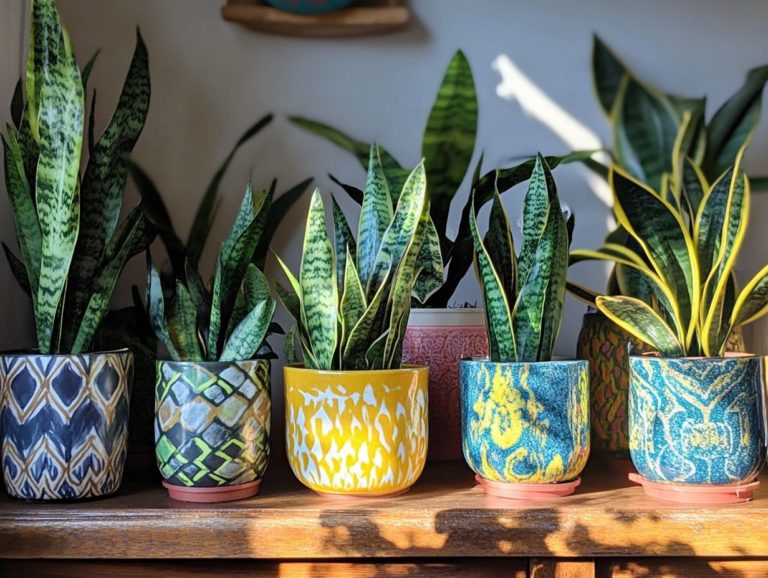Caring for Indoor Carnivorous Plants
Carnivorous plants are fascinating additions to your indoor garden! Their unique feeding habits and striking looks will surely captivate you.
To ensure their vibrant health, you’ll need to acquire specific knowledge and care techniques for how to grow carnivorous plants. This guide will equip you with everything necessary to choose the right varieties, understand their light and temperature requirements, master proper watering and feeding practices, select the ideal soil, and tackle common pests. You will also find tips on caring for hardy carnivorous species to ensure their long-term health.
Contents
- Key Takeaways:
- Choosing the Right Carnivorous Plants for Indoor Care
- Light and Temperature Requirements
- Watering and Feeding Carnivorous Plants
- Soil and Potting Considerations
- Common Pests and Diseases
- Special Care Tips for Indoor Carnivorous Plants
- Frequently Asked Questions
- What are indoor carnivorous plants?
- What types of indoor carnivorous plants are there?
- How do I care for indoor carnivorous plants?
- Can I use tap water to water my indoor carnivorous plants?
- Do indoor carnivorous plants need to be repotted?
- Do indoor carnivorous plants require special types of insects for food?
Key Takeaways:
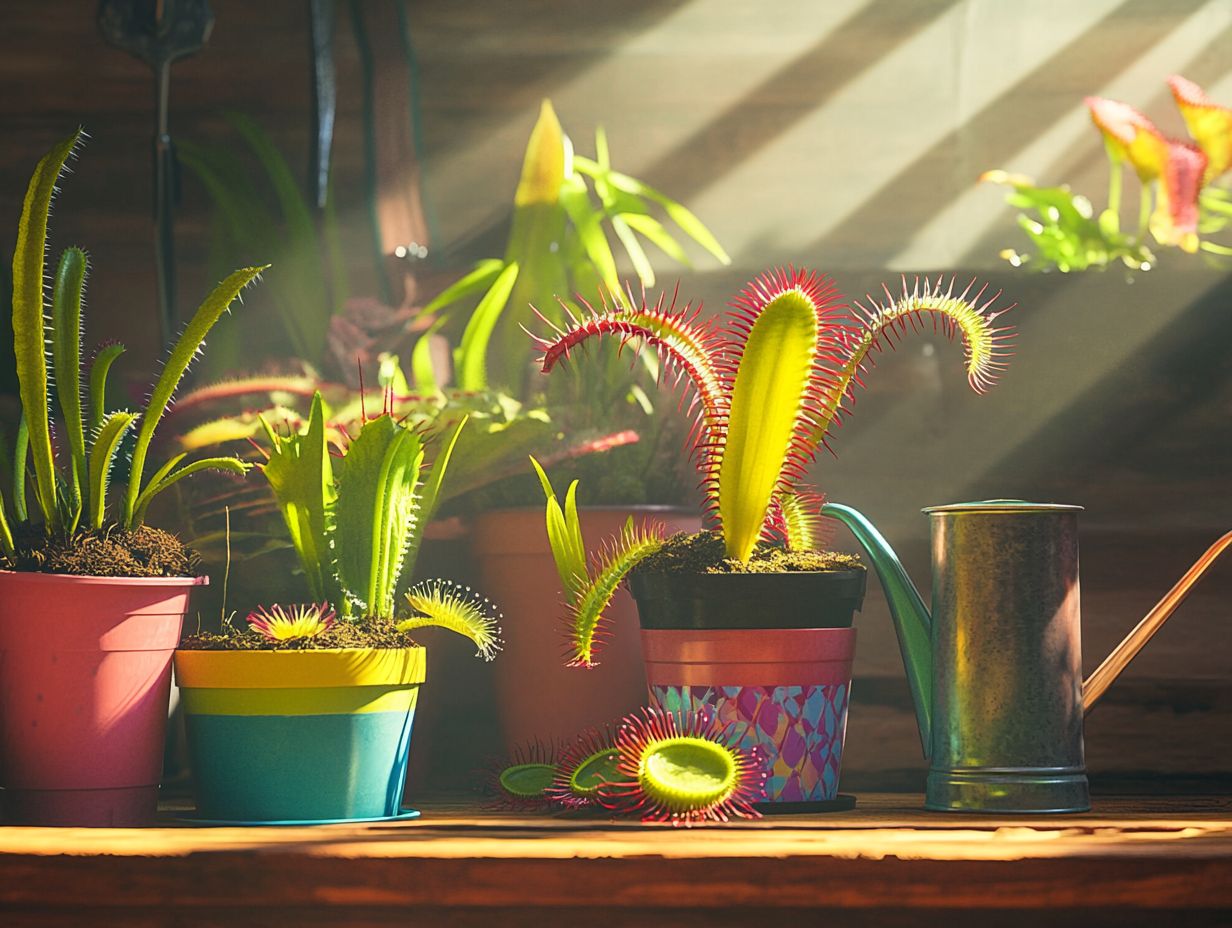
- Choose the right carnivorous plants for indoor care based on popular varieties and their specific care requirements.
- Provide optimal light and temperature conditions for indoor carnivorous plants to thrive and grow.
- Proper watering and feeding techniques, as well as using the right soil mixture, are crucial for the health of indoor carnivorous plants.
What are Carnivorous Plants?
Carnivorous plants present a captivating realm of flora, showcasing remarkable adaptations that enable them to flourish in nutrient-poor soils. They are among the most intriguing and resilient species on the planet. Picture the Venus flytrap (Dioneaea muscipula), pitcher plants (Sarracenia and Nepenthes), and sundews (Drosera), all of which capture and digest insects to supplement their nutritional needs an impressive display of nature s ingenuity.
You ll often find these remarkable organisms in various habitats. They particularly favor boggy soils or moist compost, making them favorites among enthusiasts.
These plants are equipped with specialized structures and mechanisms that are nothing short of extraordinary. Take the snap-trap of the Venus flytrap, for instance, or the slick walls of Nepenthes, both designed to lure and ensnare unsuspecting prey. Their vibrant colors and alluring scents effectively draw insects in, ensuring their survival in environments that lack essential nutrients.
In contrast, the tubular forms of Sarracenia cleverly utilize collected rainwater to trap and dissolve their meals. Each species embodies a unique blend of beauty and adaptation, underscoring their vital role in the ecosystem as nutrient recyclers and their fascinating co-evolution with various insect populations.
Choosing the Right Carnivorous Plants for Indoor Care
Choosing the right carnivorous plants for indoor care is essential for fostering their growth and ensuring their long-term health. These fascinating species come with specific requirements that must be met for them to thrive in your home.
Understanding light and humidity needs is crucial for creating a good environment for these plants that eat insects. Consider popular options such as the Venus flytrap, renowned for its striking traps, and various species of pitcher plants, which not only elevate your indoor decor but also serve as natural pest controllers.
Popular Varieties and Their Care Requirements
Among the various types of carnivorous plants, you ll discover some popular varieties that stand out, like the iconic Venus flytrap (Dionaea muscipula), a range of pitcher plants such as Sarracenia and Nepenthes, and the captivating sundews (Drosera), all of which are excellent insectivorous plants. Each of these remarkable plants has its own unique care requirements that you ll want to grasp for successful cultivation.
As you transition from the Venus flytrap s need for bright, direct sunlight and consistently moist, nutrient-poor media to the pitcher plants preference for bog-like conditions, it’s clear that these fascinating organisms have evolved extraordinary traits tailored to their environments. For instance, Sarracenia thrives in temperate conditions and peaty soils, naturally attracting insects into its deep, tubular traps. Meanwhile, the tropical Nepenthes has its own set of demands, requiring a well-draining mix and regular watering to mimic its rainforest habitat.
Regarding sundews, they opt for bright, indirect light and a sightly damp substrate, making them relatively forgiving while still delighting in a moisture-rich environment.
Light and Temperature Requirements
Understanding the light and temperature requirements for carnivorous plants is crucial for their successful growth. These intriguing species thrive best in conditions that closely resemble their natural habitats.
Many carnivorous plants, like the Venus flytrap and various types of pitcher plants, favor the bright light that a sunny windowsill offers. They also thrive in humidity levels that meet their specific environmental needs.
During the dormancy period, usually in winter, some species may require adjusted light and temperature conditions to maintain their health and vitality.
Optimal Conditions for Growth
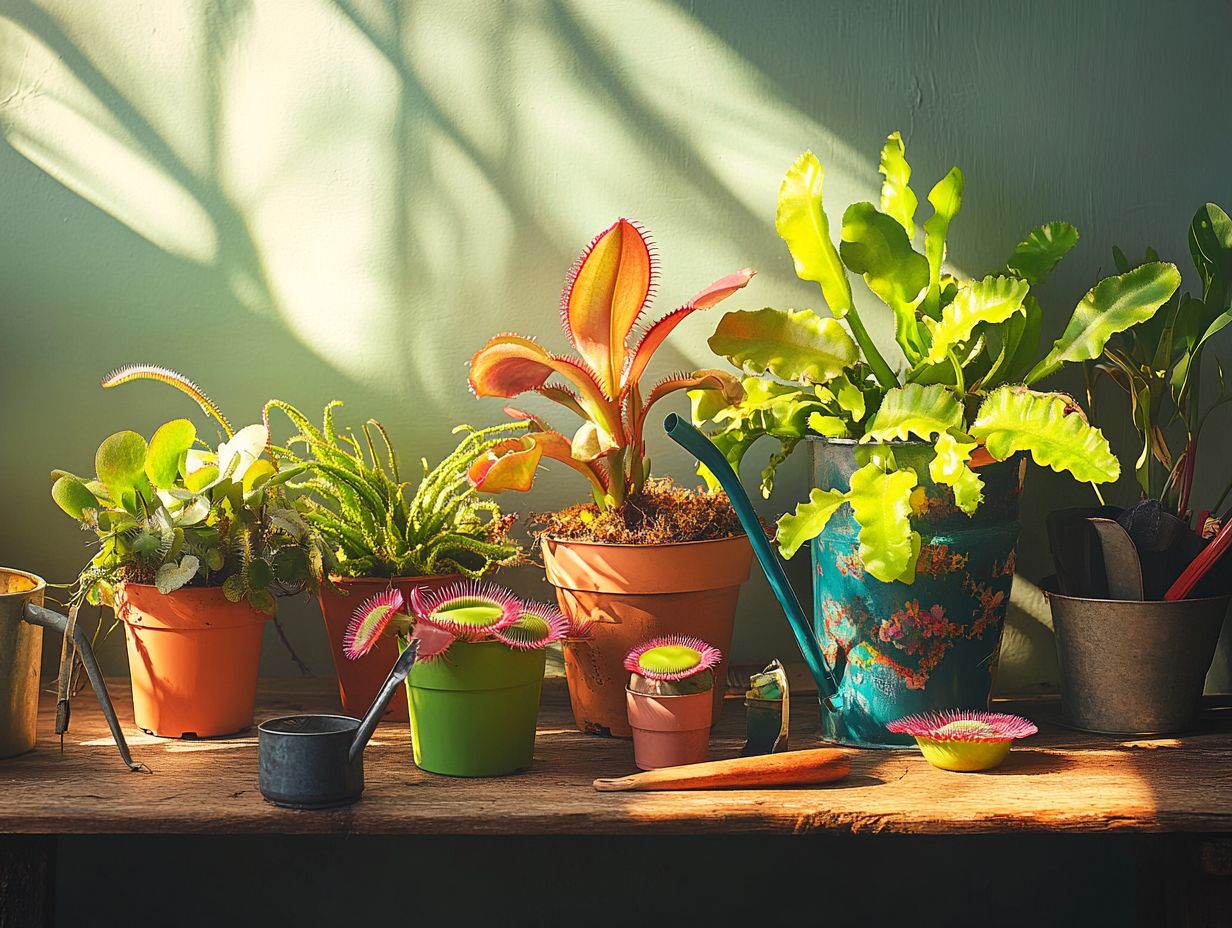
To grow healthy plants, you must establish optimal conditions that cater to their unique needs, such as humidity levels and light requirements tailored specifically to each species. These fascinating plants generally thrive in nutrient-poor soils, cleverly using their adaptations to feast on insects for essential nutrients.
By ensuring these conditions, you not only enhance their growth but also enable them to showcase their distinctive trapping mechanisms. This makes your care experience incredibly rewarding.
Achieving the right balance of light, typically bright and indirect, is crucial. This encourages photosynthesis without the risk of scorching their delicate leaves. Maintaining humidity levels around 50-70% creates a favorable microenvironment that allows moisture-loving species to flourish.
Your meticulous attention to humidity and soil composition supports their unique biology and helps prevent stress that can lead to poor growth or disease.
By fostering these tailored conditions, you ll be amazed by the captivating behaviors and striking aesthetics of carnivorous plants. You can transform any space into a vibrant ecosystem.
Watering and Feeding Carnivorous Plants
Watering and feeding carnivorous plants requires a refined approach to ensure their vitality. To properly control pests, you need to feed them insects of appropriate size.
It is crucial to use distilled water or rainwater when watering them. Tap water can introduce harmful chemicals. Providing insects every few weeks is also essential to deliver the nutrients that might be absent in their growing medium.
By mastering these techniques, including how to water carnivorous plants correctly, you can cultivate thriving specimens of these extraordinary plants and showcase their remarkable allure.
Proper Techniques for Watering and Feeding
Using the right methods for watering and feeding your carnivorous plants is essential for their vitality and overall growth. These unique specimens thrive in specific moisture and nutrient conditions.
Understanding these requirements is crucial, especially when you re cultivating species that depend on their remarkable adaptations for survival. Beyond tray watering, integrating methods like misting can help create a humid environment that mimics their natural habitats.
It s important to use distilled or rainwater; tap water often harbors minerals that can be detrimental to these delicate plants. Regarding feeding, think about the size of the prey tiny insects or specialized fertilizers designed for carnivorous varieties are ideal for maintaining their health without overwhelming them.
Balancing these factors will ultimately lead to a flourishing collection of these fascinating plants.
Soil and Potting Considerations
Selecting the right soil and potting considerations is crucial for the flourishing growth of your carnivorous plants. They need special soil that mimics their wild homes.
A well-balanced mix of ericaceous compost, peat, and horticultural sand will create an ideal substrate, ensuring excellent drainage and moisture retention both vital for their health.
Moreover, the choice of pot size and material, along with providing ample moisture and humidity levels, plays a significant role in their growth. This enables them to thrive beautifully in a carefully controlled environment.
Best Soil Mixtures for Carnivorous Plants
The ideal soil mixture for your carnivorous plants should consist of selected components that cater to their unique needs. Focus on creating a nutrient-poor environment that mimics their natural habitats.
Mix peat with horticultural sand to create a well-draining yet moisture-retentive medium. This blend closely resembles boggy soils, helping your plants thrive.
Consider adding perlite or sphagnum moss to boost aeration and improve drainage. These plants thrive in acidic environments, so use ingredients with a low pH.
Avoid fertilizers, as excess nutrients can harm them. Choosing the right soil mixture ensures optimal growth and creates conditions for them to capture and digest prey effectively.
Common Pests and Diseases
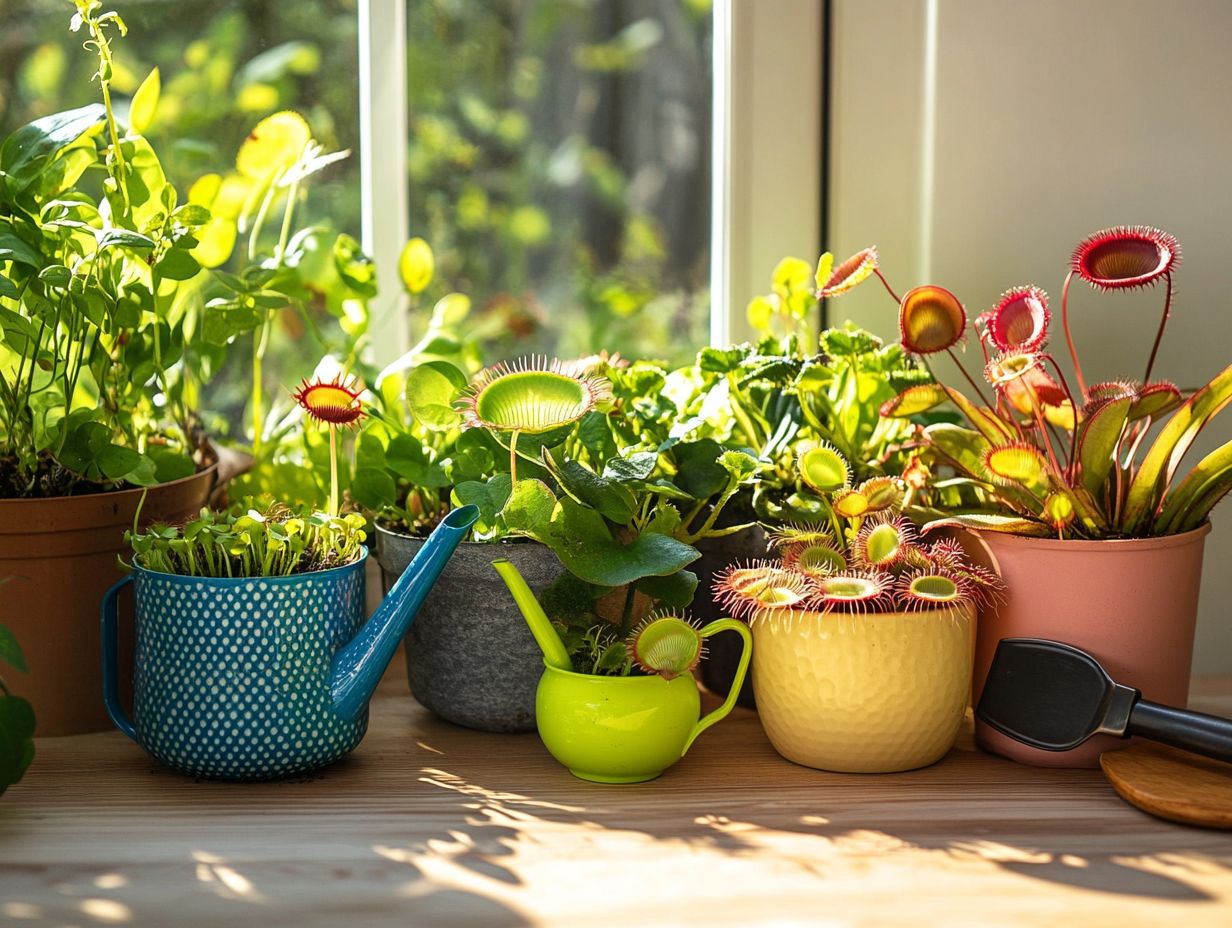
Understanding common pests and diseases that can affect your carnivorous plants is crucial for their health. Recognizing these threats is the first step to prevention.
Pests like aphids and spider mites can stunt growth and impair trapping abilities. Use natural pest control strategies, such as introducing beneficial insects like Phytoseiulus persimilis, to manage infestations.
Identifying and Treating Common Issues
Identifying problems with carnivorous plants is key to maintaining their health. Knowing potential pests and diseases allows you to act quickly.
Aphids and spider mites often hide on leaves and traps, making it hard for the plant to catch prey. Using simple pest management methods can improve your plant care.
Regularly monitor your plants for signs of pests or diseases. Recognize symptoms of root rot or fungal infections that can arise from overwatering or poor drainage.
Use organic solutions like neem oil or insecticidal soap to manage pest populations safely. Ensure adequate humidity and light to help your plants thrive in their environment.
Special Care Tips for Indoor Carnivorous Plants
Special care tips can greatly enhance your indoor carnivorous plants’ growth and overall health. These resilient species can thrive beautifully in your home.
Maintain proper humidity levels, as many carnivorous plants need a moist atmosphere. Meeting their light requirements and using correct watering and feeding techniques will create a vibrant indoor ecosystem. For those interested in specific plant care, caring for indoor sweetheart plants can also enhance your indoor gardening experience.
Additional Tips for Maintaining Healthy Plants
To maintain healthy carnivorous plants, it’s essential to adopt complete care that encompasses various strategies, ensuring that all their needs are met. Regularly monitor moisture levels, humidity, and light exposure to significantly influence their growth and vitality. Employ effective watering techniques tailored to their unique requirements.
Be proactive with pest control to avoid infestations. This allows these remarkable plants to thrive indoors!
Creating the right environment is crucial. Carnivorous plants flourish in conditions that mimic their native habitats. Consider using distilled or rainwater for irrigation, as tap water may contain minerals that could harm these varieties. For indoor care, place your plants in a humid setting or utilize pebble trays to enhance humidity, crafting a suitable microclimate. Following the best practices for propagating carnivorous plants can further ensure their healthy growth.
Keep an eye out for pests like aphids or spider mites. Regular checks can protect against potential damage. Implement gentle organic methods, such as neem oil (a natural pesticide), to effectively manage pests without harming the plant.
By embracing these comprehensive care strategies, you can nurture healthy plants that showcase both resilience and beauty. Start your carnivorous plant journey now!
Frequently Asked Questions
What are indoor carnivorous plants?

Indoor carnivorous plants are a type of plant that feeds on insects and other small organisms to supplement their diet. They typically have specialized leaves or traps to catch prey.
What types of indoor carnivorous plants are there?
- Venus flytraps
- Pitcher plants
- Sundews
- Butterworts
Each type has its unique characteristics and care requirements.
How do I care for indoor carnivorous plants?
Caring for indoor carnivorous plants involves providing them with the right growing conditions, including proper lighting, temperature, and moisture levels. They require a special type of soil and regular feeding with insects or a specialized fertilizer.
Can I use tap water to water my indoor carnivorous plants?
No, tap water often contains high levels of minerals and chemicals that can be harmful to carnivorous plants. It is best to use distilled or rainwater to water these plants, as it mimics their natural growing conditions.
Do indoor carnivorous plants need to be repotted?
Yes, indoor carnivorous plants should be repotted every year or two to ensure they have enough space and nutrients to grow. Use a potting mix specifically designed for carnivorous plants and be gentle when repotting to avoid damaging their delicate roots.
Do indoor carnivorous plants require special types of insects for food?
Yes, most indoor carnivorous plants require live insects for their diet. However, there are specialized fertilizers available that provide the necessary nutrients for these plants without the need for live food.

